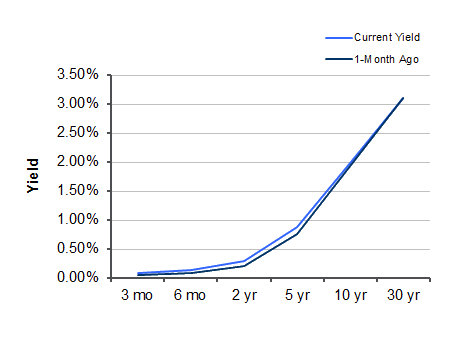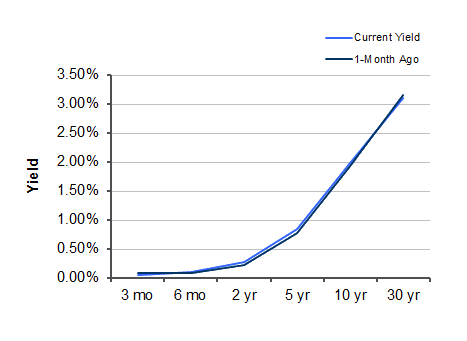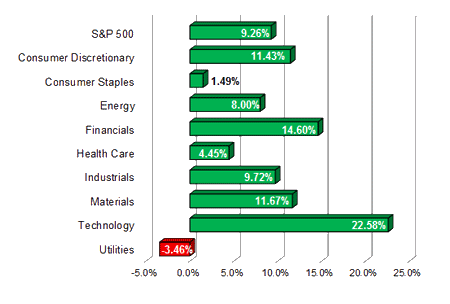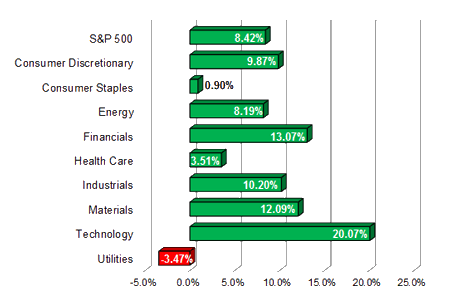The Weekly Market Snapshot from Frazier Allen for the week of April 15th, 2012
April 15, 2012

Market Commentary by Scott J. Brown, Ph.D., Chief Economist

Scott J. Brown Ph.D., Chief Economist Raymond James Investment Services
The stock market began the week with a (negative) reaction to the March Employment Report (which was softer than expected, but not terrible). Worries about Europe and global growth also weighed against market sentiment – the fear subsided a bit on Wednesday and Thursday, but appeared to return on Friday. Fed officials suggest that monetary policy was conditional on how the economy develops – although no action is expected anytime soon.
The economic data remained consistent with moderate growth and moderate inflation. As expected, the seasonal adjustment dampened the impact of higher gasoline prices in the Consumer Price Index. The core CPI rose 2.3% y/y. The Fed’s Beige Book noted “modest to moderate” economic growth. [Read more]
The Weekly Market Snapshot from Frazier Allen for the week of April 10th, 2012
April 10, 2012

Market Commentary by Scott J. Brown, Ph.D., Chief Economist

Scott J. Brown Ph.D., Chief Economist Raymond James Investment Services
The minutes of the March 13 Federal Open Market Committee meeting suggested reduced odds of another round of Fed asset purchases (QE3). That shouldn’t have been a surprise to anyone, but the news was taken negatively by the stock market and long-term Treasury yields snapped higher. The European Central Bank left rates changed, but ECP president Draghi seemed a bit hawkish in his post-meeting press conference, renewing concerns about the European financial crisis (I guess, it wouldn’t seem like spring otherwise).
The U.S. economic data (this is being written before the release of the March Employment Report) remained consistent with moderate growth. ISM figures were mixed, but both reports showed further growth in new orders and employment. [Read more]
The Weekly Market Snapshot from Frazier Allen for the week of April 1st, 2012
April 1, 2012

Market Commentary by Scott J. Brown, Ph.D., Chief Economist

Scott J. Brown Ph.D., Chief Economist Raymond James Investment Services
The week began with a speech by Fed Chairman Bernanke, where he noted that “further significant improvements in the unemployment rate will likely require a more-rapid expansion of production and demand from consumers and businesses, a process that can be supported by continued accommodative policies.”Many interpreted this to mean that further asset purchases (QE3) were still on the table (if somewhat unlikely). Concerns about softer global growth seemed to weigh against equity market sentiment through the middle of the week. Quarter-end likely window-dressing added a bit to market volatility. Bond yields fell.
The economic data reports were mixed. The personal income and spending figures were probably the most important, but were not fully appreciated by the markets. [Read more]
The Weekly Market Snapshot from Frazier Allen for the week of March 11th, 2012
March 11, 2012

Market Commentary by Scott J. Brown, Ph.D., Chief Economist

Scott J. Brown Ph.D., Chief Economist Raymond James Investment Services
Worries about the Greek debt swap agreement weighed against global stock markets earlier in the week, but confidence returned as the Greek deal looked like it would succeed. The February job market figures were strong, a positive for equities and a negative for bonds, but most of that news was already factored in.
Nonfarm payrolls rose by 227,000 in February, while the two previous months were revised a net 61,000 higher (leaving the three-month average at 245,000). The unemployment rate held steady at 8.3%, but that was despite an increase in labor force participation (which rose from 63.7% to 63.9%). The employment-to-population ratio edged up to 58.6%, vs. 58.5% in January and 58.4% in December. It’s likely that the unusually mild winter had a significant impact on payrolls, hours, and labor force participation. [Read more]
The Weekly Market Snapshot from Frazier Allen for the week of March 4th, 2012
March 4, 2012

Market Commentary by Scott J. Brown, Ph.D., Chief Economist

Scott J. Brown Ph.D., Chief Economist Raymond James Investment Services
The economic data reports were mixed. Real GDP rose at a 3.0% annual rate in the 2nd estimate for 4Q11 (vs. +2.8% in the advance estimate), with slight upward revisions to consumer spending and business fixed investment. The details of the report showed a significant upward revision to estimates of personal income for both 3Q11 and 4Q11 (that news, suggesting that the trend in income wasn’t especially strong, but a lot less weak than previously estimated, went largely unnoticed by the markets).
Consumer spending was softer than expected in February, held down partly by a weather-related decrease in energy consumption (ex-energy, spending rose 0.4%). Still, adjusted for inflation, consumer spending was flat for the third consecutive month in January. Since consumer spending accounts for 70% of overall GDP, these data suggest that first quarter growth may be a lot weaker than was hoped for earlier.
Unit auto sales jumped to a 15.0 million seasonally adjusted annual rate in February, up from 14.1 million in January and 13.0 million a year ago. The February ISM Manufacturing Index fell. Consumer confidence improved, but the survey missed much of the recent increase in gasoline prices.
In his semi-annual testimony on monetary policy, Fed Chairman Bernanke said that recent information “is consistent with growth proceeding, in coming quarters, at a pace close to or somewhat above the pace that was registered during the second half of last year (about 2¼%).” Bernanke noted that “continued improvement in the job market is likely to require stronger growth in final demand and production” and added that “strains in global financial markets pose significant downside risks to the economic outlook.” However, the markets focused on what he didn’t say – that is, there was no hint of further asset purchases in the near term.
Next week, the focus is expected to be on Friday’s job market report. Seasonal adjustment will remain an important factor in February, adding, along with the weather, considerable uncertainty to the payroll estimate. However, it’s unclear whether mild weather has pulled forward gains that normally would have occurred in March and April (as is often the case). More troublesome, high gasoline prices, if sustained, are likely to dampen the pace of hiring for smaller firms.
Indices
| Last | Last Week | YTD return % | |
| DJIA | 12980.30 | 12984.69 | 6.24% |
| NASDAQ | 2988.97 | 2956.98 | 14.73% |
| S&P 500 | 1374.09 | 1363.46 | 9.26% |
| MSCI EAFE | 1570.58 | 1559.01 | 11.19% |
| Russell 2000 | 815.22 | 829.23 | 10.03% |
Consumer Money Rates
| Last | 1-year ago | |
| Prime Rate | 3.25 | 3.25 |
| Fed Funds | 0.12 | 0.16 |
| 30-year mortgage | 3.93 | 4.83 |
Currencies
| Last | 1-year ago | |
| Dollars per British Pound | 1.595 | 1.628 |
| Dollars per Euro | 1.332 | 1.381 |
| Japanese Yen per Dollar | 81.140 | 81.860 |
| Canadian Dollars per Dollar | 0.985 | 0.974 |
| Mexican Peso per Dollar | 12.739 | 12.094 |
Commodities
| Last | 1-year ago | |
| Crude Oil | 108.84 | 99.63 |
| Gold | 1717.68 | 1428.55 |
Bond Rates
| Last | 1-month ago | |
| 2-year treasury | 0.27 | 0.23 |
| 10-year treasury | 1.98 | 1.93 |
| 10-year municipal (TEY) | 2.93 | 2.66 |
Treasury Yield Curve – 3/02/2012
S&P Sector Performance (YTD) – 3/02/2012
Economic Calendar
| March 5th |
— |
ISM Non-Manufacturing Index (February) |
| March 7th |
— |
ADP Payroll Estimate (February) |
| March 8th |
— |
Jobless Claims (week ending March 3rd) |
| March 9th |
— |
Employment Report (February) |
| March 13th |
— |
Retail Sales (February) FOMC Policy Decision (no press briefing) |
| March 16th |
— |
Consumer Price Index (February) |
| April 6th |
— |
Good Friday (stock market closed, bonds open half a day) Employment Report (March) |
| April 25th |
— |
FOMC Policy Decision Bernanke Press Briefing |
Important Disclosures
US government bonds and treasury bills are guaranteed by the US government and, if held to maturity, offer a fixed rate of return and guaranteed principal value. US government bonds are issued and guaranteed as to the timely payment of principal and interest by the federal government. Treasury bills are certificates reflecting short-term (less than one year) obligations of the US government.
Commodities trading is generally considered speculative because of the significant potential for investment loss. Markets for commodities are likely to be volatile and there may be sharp price fluctuations even during periods when prices overall are rising. Specific sector investing can be subject to different and greater risks than more diversified investments.
Tax Equiv Muni yields (TEY) assume a 35% tax rate on triple-A rated, tax-exempt insured revenue bonds.
![]() Material prepared by Raymond James for use by its financial advisors.
Material prepared by Raymond James for use by its financial advisors.
The information contained herein has been obtained from sources considered reliable, but we do not guarantee that the foregoing material is accurate or complete. Data source: Bloomberg, as of close of business March 1st, 2012.
©2012 Raymond James Financial Services, Inc. member FINRA / SIPC.
The Weekly Market Snapshot from Frazier Allen for the week of February 27th, 2012
February 27, 2012

Market Commentary by Scott J. Brown, Ph.D., Chief Economist

Scott J. Brown Ph.D., Chief Economist Raymond James Investment Services
A deal was reached in the €130 billion bailout package for Greece. However, investors almost immediately began to doubt Greece’s ability to stick to the plan (especially given the unrealistic assumptions about Greece’s growth prospects). Meanwhile, oil and gasoline prices continued to rise, posing a more significant threat to the U.S. growth outlook.
The economic calendar was relatively thin. Home sales figures were mixed, but January housing data aren’t all that critical. Jobless claims continued to trend at a relatively low level. Consumer sentiment rebounded from a dip in the middle of the month, apparently as job market optimism offset worries about higher gasoline prices.
Next week, the calendar heats up again.
The Fed Chairman’s semi-annual monetary policy testimony to Congress (to the House Financial Services Committee on Wednesday and to the Senate Banking Committee on Thursday) is often a big deal for the markets, but we’re unlikely to learn much this week. That is, Bernanke should present a moderate, but uncertain economic outlook.
Monetary policy changes (more QE) would depend on a loss of momentum in growth or expectations that inflation will be below target. The estimate of 4Q11 GDP growth is expected to be little changed from the advance estimate (+2.8%). The Beige Book will provide anecdotal evidence of what’s going on with the economy (expected to be a bit brighter than the previous assessment).
Indices
| Last | Last Week | YTD return % | |
| DJIA | 12984.69 | 12904.08 | 6.28% |
| NASDAQ | 2956.98 | 2959.85 | 13.51% |
| S&P 500 | 1363.46 | 1358.04 | 8.42% |
| MSCI EAFE | 1559.01 | 1530.02 | 10.37% |
| Russell 2000 | 829.23 | 829.96 | 11.92% |
Consumer Money Rates
| Last | 1-year ago | |
| Prime Rate | 3.25 | 3.25 |
| Fed Funds | 0.11 | 0.16 |
| 30-year mortgage | 3.88 | 4.90 |
Currencies
| Last | 1-year ago | |
| Dollars per British Pound | 1.570 | 1.620 |
| Dollars per Euro | 1.332 | 1.374 |
| Japanese Yen per Dollar | 80.180 | 82.380 |
| Canadian Dollars per Dollar | 0.999 | 0.993 |
| Mexican Peso per Dollar | 12.842 | 12.208 |
Commodities
| Last | 1-year ago | |
| Crude Oil | 107.49 | 96.50 |
| Gold | 1786.48 | 1415.63 |
Bond Rates
| Last | 1-month ago | |
| 2-year treasury | 0.30 | 0.21 |
| 10-year treasury | 1.98 | 1.93 |
| 10-year municipal (TEY) | 2.94 | 2.92 |
Treasury Yield Curve – 2/24/2012
 S&P Sector Performance (YTD) – 2/24/2012
S&P Sector Performance (YTD) – 2/24/2012
Economic Calendar
| February 27th |
— |
Pending Home Sales Index (January) |
| February 28th |
— |
Durable Goods Orders (January) S&P/Case-Shiller Home Price Index (December) Consumer Confidence (January) |
| February 29th |
— |
Real GDP (4Q11, 2nd estimate) Chicago PM Index (February) Bernanke Monetary Policy Testimony (House) Fed Beige Book |
| February 30th |
— |
Jobless Claims (week ending February 25th) Personal Income and Spending (January) ISM Manufacturing Index (February) Bernanke Monetary Policy (Senate) Motor Vehicle Sales (February) |
| March 9th |
— |
Employment Report (February) |
| March 13th |
— |
FOMC Policy Decision (no press briefing) |
| March 16th |
— |
Consumer Price Index (February) |
Important Disclosures
US government bonds and treasury bills are guaranteed by the US government and, if held to maturity, offer a fixed rate of return and guaranteed principal value. US government bonds are issued and guaranteed as to the timely payment of principal and interest by the federal government. Treasury bills are certificates reflecting short-term (less than one year) obligations of the US government.
Commodities trading is generally considered speculative because of the significant potential for investment loss. Markets for commodities are likely to be volatile and there may be sharp price fluctuations even during periods when prices overall are rising. Specific sector investing can be subject to different and greater risks than more diversified investments.
Tax Equiv Muni yields (TEY) assume a 35% tax rate on triple-A rated, tax-exempt insured revenue bonds.
![]() Material prepared by Raymond James for use by its financial advisors.
Material prepared by Raymond James for use by its financial advisors.
The information contained herein has been obtained from sources considered reliable, but we do not guarantee that the foregoing material is accurate or complete. Data source: Bloomberg, as of close of business February 23rd, 2012.
©2012 Raymond James Financial Services, Inc. member FINRA / SIPC.
The Weekly Market Snapshot from Frazier Allen for the week of February 20th, 2012
February 20, 2012

Market Commentary by Scott J. Brown, Ph.D., Chief Economist

Scott J. Brown Ph.D., Chief Economist Raymond James Investment Services
The Greek soap opera continued, but investors took some encouragement in the hope that a deal will be soon reached. Bond yields backed up on reduced fear about Europe and on reduced odds of further Fed asset purchases.
The January 24-25 Fed policy meeting minutes showed only “a few” officials leaning toward QE3, although others thought such action would be warranted if “the economy lost momentum or if inflation seemed likely to remain below the (2%) inflation mandate over the medium term.” Fed officials continued to see an unusually high level of uncertainty surrounding the outlooks for growth and unemployment.
The Consumer Price Index rose 0.2% in January (+2.9% year-over-year), up 0.2% ex-food & energy (+2.3% year-over-year). Bear in mind that the Fed’s inflation target gauge, the PCE Price Index, usually runs about 0.2 or 0.3 percentage points below the CPI (hence, core consumer price inflation appears to be right on target on a year-over-year basis). [Read more]
The Weekly Market Snapshot from Frazier Allen for the week of February 12th, 2012
February 12, 2012

Market Commentary by Scott J. Brown, Ph.D., Chief Economist

Scott J. Brown Ph.D., Chief Economist Raymond James Investment Services
Global equity markets rallied on progress on a Greek bailout package, but reacted negatively as Greece stumbled as it approached the finish line. In the U.S., investors began to question whether the stock market rally has gone too fast in 2012.
The economic calendar was thin. Consumer credit rose sharply in December, following a strong gain in November, apparently reflecting the improvement in motor vehicle sales. The trade deficit was narrower than expected in December (implying, all else equal, a small upward revision to the 4Q11 GDP growth estimate).
Five big banks reached a foreclosure settlement with the attorneys general of 49 states and the Obama administration, which will provide mortgage adjustments for about 10% of those underwater on their mortgages and distribute checks of around $2000 to about 750,000 who were foreclosed upon through faulty or fraudulent practices. The settlement should help the housing sector to some extent, but is not expected to lead to a sharp recovery.
Next week, the economic calendar turns busy. The focus is likely to be on the reports of retail sales and consumer prices. Seasonal adjustment may magnify the impact of unusually mild weather in January (likely apparent in residential construction and industrial production). The White House’s Office of Management and Budget will release its budget outlook on Monday.
Significant deficit reduction is expected in this plan, following required discretionary spending cuts from last year’s Budget Control Act, but it will be interesting to see what gets cut and whether there will be a push to soften or postpone scheduled tax increases (the Bush tax cuts and the reduction in payroll taxes). Note that the payroll tax reduction, which is set to expire at the end of February, has yet to be extended for the full calendar year.
Indices
| Last | Last Week | YTD return % | |
| DJIA | 12890.461 | 12705.41 | 5.51% |
| NASDAQ | 2927.23 | 2859.68 | 12.36% |
| S&P 500 | 1351.95 | 1325.54 | 7.50% |
| MSCI EAFE | 1549.80 | 1518.58 | 9.72% |
| Russell 2000 | 824.99 | 812.89 | 11.35% |
Consumer Money Rates
| Last | 1-year ago | |
| Prime Rate | 3.25 | 3.25 |
| Fed Funds | 0.12 | 0.13 |
| 30-year mortgage | 3.89 | 5.06 |
Currencies
| Last | 1-year ago | |
| Dollars per British Pound | 1.583 | 1.610 |
| Dollars per Euro | 1.330 | 1.371 |
| Japanese Yen per Dollar | 77.530 | 82.370 |
| Canadian Dollars per Dollar | 0.994 | 0.994 |
| Mexican Peso per Dollar | 12.712 | 12.051 |
Commodities
| Last | 1-year ago | |
| Crude Oil | 99.84 | 86.71 |
| Gold | 1739.40 | 1363.03 |
Bond Rates
| Last | 1-month ago | |
| 2-year treasury | 0.27 | 0.22 |
| 10-year treasury | 1.98 | 1.86 |
| 10-year municipal (TEY) | 2.85 | 2.85 |
Treasury Yield Curve – 2/10/2012
S&P Sector Performance (YTD) – 2/10/2012
Economic Calendar
| February 13th |
— |
OMB Budget Outlook |
| February 14th |
— |
Small Business Optimism (January) Import Prices (January) Retail Sales (January |
| February 15th |
— |
Empire St. Manufacturing Index (February) Industrial Production (January) Homebuilder Sentiment (February) FOMC Minutes (January 1/24th-25th) |
| February 16th |
— |
Jobless Claims (week ending February 11th) Producer Price Index (January) Building Permits, Housing Starts (January) Philadelphia Fed Index (February) |
| February 17th |
— |
Consumer Price Index (January) Leading Economic Indicators (January) |
| February 20th |
— |
President’s Day Holiday (markets closed) |
| March 9th |
— |
Employment Report (February) |
| March 13th |
— |
FOMC Policy Decision (no press briefing) |
Treasury Yield Curve – 2/3/2012
S&P Sector Performance (YTD) – 2/3/2012
Economic Calendar
| February 7th |
— |
Bernanke Testimony (Senate Budget Committee) |
| February 9th |
— |
Jobless Claims (week ending February 4th) |
| February 10th |
— |
Trade Balance (December) Consumer Sentiment (mid-January) |
| February 14th |
— |
Retail Sales (January) |
| February 15th |
— |
Industrial Production (January) |
| February 16th |
— |
Producer Price Index (January) Building Permits, Housing Starts (January) |
| February 17th |
— |
Consumer Price Index (January) |
| February 20th |
— |
President’s Day Holiday (markets closed) |
| March 9th |
— |
Employment Report (February) |
| March 13th |
— |
FOMC Policy Decision (no press briefing) |
Important Disclosures
Past performance is not a guarantee of future results. There are special risks involved with global investing related to market and currency fluctuations, economic and political instability, and different financial accounting standards. The above material has been obtained from sources considered reliable, but we do not guarantee that it is accurate or complete. There is no assurance that any trends mentioned will continue in the future. While interest on municipal bonds is generally exempt from federal income tax, it may be subject to the federal alternative minimum tax, state or local taxes. In addition, certain municipal bonds (such as Build America Bonds) are issued without a federal tax exemption, which subjects the related interest income to federal income tax. Investing involves risk and investors may incur a profit or a loss.
US government bonds and treasury bills are guaranteed by the US government and, if held to maturity, offer a fixed rate of return and guaranteed principal value. US government bonds are issued and guaranteed as to the timely payment of principal and interest by the federal government. Treasury bills are certificates reflecting short-term (less than one year) obligations of the US government.
Commodities trading is generally considered speculative because of the significant potential for investment loss. Markets for commodities are likely to be volatile and there may be sharp price fluctuations even during periods when prices overall are rising. Specific sector investing can be subject to different and greater risks than more diversified investments.
Tax Equiv Muni yields (TEY) assume a 35% tax rate on triple-A rated, tax-exempt insured revenue bonds.
![]() Material prepared by Raymond James for use by its financial advisors.
Material prepared by Raymond James for use by its financial advisors.
The information contained herein has been obtained from sources considered reliable, but we do not guarantee that the foregoing material is accurate or complete. Data source: Bloomberg, as of close of business February 9th, 2012.
©2012 Raymond James Financial Services, Inc. member FINRA / SIPC.
The Weekly Market Snapshot from Frazier Allen for the week of February 5th, 2012
February 5, 2012

Market Commentary by Scott J. Brown, Ph.D., Chief Economist

Scott J. Brown Ph.D., Chief Economist Raymond James Investment Services
The economic data were mixed, but remained consistent with moderate growth in the near term. Consumer confidence fell in January. Motor vehicle sales picked up. Home prices were still falling in November. Construction spending improved in December (likely reflecting mild weather). The January Employment Report was stronger than expected, helped by mild weather. Nonfarm payrolls rose by 243,000 and the two previous months were revised a net 60,000 higher (note that payrolls fell by 2.689 million in January before seasonal adjustment).
The unemployment rate fell to 8.3%, from 8.5% in December and 9.1% a year ago, due largely to a drop in labor force participation. The employment/population ratio held steady at 58.5%, little changed over the last two years. The Household Survey results noted that 206,000 people were not able to work during the January survey period due to adverse weather, vs. a 425,000 average over the last five Januarys (this figure is not directly comparable to the payroll numbers, but it gives you an idea of the magnitude of the weather impact). [Read more]
The Weekly Market Snapshot from Frazier Allen for the week of January 29th, 2012
January 29, 2012

Market Commentary by Scott J. Brown, Ph.D., Chief Economist

Scott J. Brown Ph.D., Chief Economist Raymond James Investment Services
The Federal Open Market Committee left short-term interest rates unchanged and did not embark on another round of asset purchases. No surprise there. However, the FOMC lengthened the period it expects to keep rates exceptionally low: the FOMC “currently anticipates that economic conditions – including low rates of resource utilization and a subdued outlook for inflation over the medium run – are likely to warrant exceptionally low levels for the federal funds rate at least through late 2014” (vs. the previous “through mid-2013”).
Keeping to its dual mandate (price stability and maximum sustainable employment) the Fed adopted an explicit inflation target (inflation in the PCE Price Index at 2% per year) and a soft target for employment (currently, an unemployment rate between 5.2% and 6.0%). In the post-meeting press briefing, Chairman Bernanke said that officials were still debating whether to increase the Fed’s asset purchases. [Read more]














